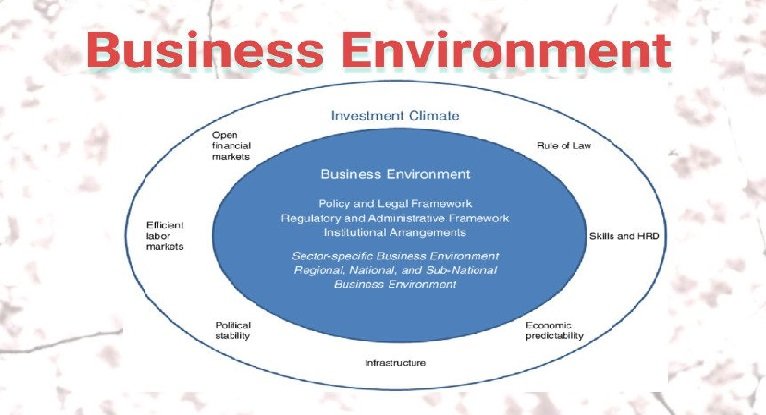Table of Contents
ToggleBusiness Environment PDF: Understanding Its Importance and Impact on Organizations
In today’s rapidly changing world, understanding the business environment is crucial for the survival and growth of any organization. The business environment encompasses a range of external and internal factors that influence the functioning, decisions, and operations of businesses. These factors can range from economic conditions, political stability, and technological advancements to social and cultural influences. A business environment PDF serves as an essential resource for studying these dynamics, offering a detailed analysis of various elements and their impact on businesses. This article will explore the significance of the business environment, key factors involved, and how businesses can adapt to thrive within it.
The Concept of Business Environment
The term “business environment” refers to the combination of external and internal factors that affect a company’s operations, performance, and decision-making processes. The external environment includes factors outside the organization that can influence its success, such as government policies, economic conditions, and technological changes. On the other hand, the internal environment consists of factors within the company, like its organizational culture, management practices, and resources.
Understanding the business environment is crucial for businesses as it helps them anticipate changes, identify opportunities, and avoid potential risks. By analyzing the business environment, organizations can develop strategies to align their operations with the ever-changing market conditions.
Key Elements of the Business Environment
Several key elements form the foundation of the business environment. These elements interact with each other and influence a company’s operations in different ways. Some of the most critical components include:
1. Economic Environment
The economic environment refers to the overall state of the economy and its impact on businesses. It includes factors such as inflation rates, interest rates, unemployment levels, and economic growth. These factors affect consumer purchasing power, production costs, and market demand.
For example, during times of economic recession, businesses may face lower demand for products and services, leading to a decline in sales and profits. Conversely, during periods of economic expansion, businesses may experience higher demand, increased profitability, and growth opportunities.
2. Political and Legal Environment
The political and legal environment encompasses the laws, regulations, and political stability of a country or region. Government policies, such as taxation, trade regulations, labor laws, and environmental standards, have a direct impact on how businesses operate. Additionally, political stability influences the confidence of investors and businesses.
For instance, a government that implements favorable trade policies and tax incentives can create a conducive environment for businesses to flourish. However, political instability, corruption, or frequent changes in regulations can create uncertainty and hinder business growth.
3. Technological Environment
The technological environment refers to advancements in technology that affect how businesses produce goods and services. The rapid pace of technological innovation has reshaped industries, creating new opportunities and challenges for organizations. From automation to artificial intelligence, businesses must adapt to new technologies to remain competitive.
For example, the rise of e-commerce and digital marketing has transformed traditional retail businesses, requiring them to adopt new strategies and tools. Failure to embrace technological advancements can lead to a decline in market share and missed opportunities for growth.
4. Social and Cultural Environment
The social and cultural environment includes societal values, beliefs, and cultural norms that influence consumer behavior, employee expectations, and market trends. Changes in demographics, lifestyle, and social attitudes can significantly impact business strategies.
For instance, the growing awareness of environmental sustainability has led to increased demand for eco-friendly products. Similarly, changes in consumer preferences, such as the shift toward healthy living, can drive businesses to adjust their product offerings and marketing strategies.
5. Competitive Environment
The competitive environment refers to the level of competition within an industry and how businesses interact with one another. Companies must monitor the competitive landscape to understand the strategies and actions of their rivals. This includes analyzing competitors’ pricing, marketing, and innovation efforts.
The presence of strong competitors can force businesses to innovate and improve their offerings. In contrast, a lack of competition in a particular market can lead to complacency and reduced innovation.
6. Natural Environment
The natural environment includes the physical environment, such as natural resources, climate conditions, and ecological factors. Companies must consider environmental factors in their operations, especially in industries that rely on natural resources. Environmental sustainability has become a significant concern, with businesses adopting practices that minimize their environmental impact.
For instance, businesses in industries such as manufacturing, agriculture, and energy must adhere to environmental regulations and adopt green technologies to reduce pollution and conserve resources.
The Importance of a Business Environment PDF
A business environment PDF serves as a valuable tool for business professionals, students, and researchers to better understand the complexities of the business world. These documents provide in-depth analysis and research on various aspects of the business environment, often backed by case studies, statistical data, and expert opinions. Here are a few reasons why a business environment PDF is essential:
1. Comprehensive Understanding
A business environment PDF offers a comprehensive overview of the various elements that affect businesses. It allows readers to grasp the interconnectedness of different factors, from economic conditions to technological advancements. Understanding these elements is crucial for making informed business decisions and developing strategies that can lead to success.
2. Updated Information
The business environment is constantly changing. Government policies, economic conditions, and technological advancements evolve over time, creating new challenges and opportunities. A business environment PDF typically includes up-to-date information and insights, making it an essential resource for staying informed about current trends.
3. Educational Value
For students and aspiring professionals, a business environment PDF serves as an excellent educational resource. It provides detailed explanations, examples, and case studies that help in the learning process. Whether studying for exams or conducting research, these PDFs can enhance the knowledge of the business environment.
4. Strategic Decision-Making
For business leaders and decision-makers, understanding the business environment is key to strategic planning. A business environment PDF provides valuable insights into market trends, consumer behavior, and industry dynamics, which are crucial for formulating business strategies that drive growth and profitability.
How Businesses Can Adapt to the Business Environment
Given the ever-changing nature of the business environment, companies must be agile and adaptable to survive and thrive. Here are some strategies businesses can adopt:
1. Regular Environmental Scanning
Businesses should engage in environmental scanning to stay aware of external and internal changes. This involves continuously monitoring factors such as market trends, technological innovations, political developments, and competitor activities. By staying informed, businesses can anticipate potential threats and capitalize on emerging opportunities.
2. Embracing Innovation and Technology
Adapting to technological advancements is essential for business success. Companies should invest in new technologies, automation, and digital transformation to improve efficiency, reduce costs, and enhance customer experience. Innovation is key to staying ahead of the competition and meeting the changing demands of consumers.
3. Building Strong Relationships with Stakeholders
Building strong relationships with customers, employees, suppliers, and other stakeholders is essential for long-term success. By understanding the needs and expectations of stakeholders, businesses can better align their products, services, and operations to meet market demands.
4. Sustainability Practices
As environmental concerns grow, businesses must adopt sustainable practices to minimize their ecological footprint. This includes reducing waste, conserving resources, and adopting green technologies. Sustainability is not only good for the planet but also enhances a company’s reputation and attracts environmentally conscious consumers.
Conclusion
The business environment is dynamic and multifaceted, encompassing a variety of factors that impact business operations. Understanding these elements is crucial for companies to navigate challenges, seize opportunities, and remain competitive. A business environment PDF serves as an essential resource, providing valuable insights into the external and internal factors that influence business decisions. By regularly analyzing the business environment, embracing innovation, and staying adaptable, businesses can position themselves for long-term success in an ever-changing market landscape.




